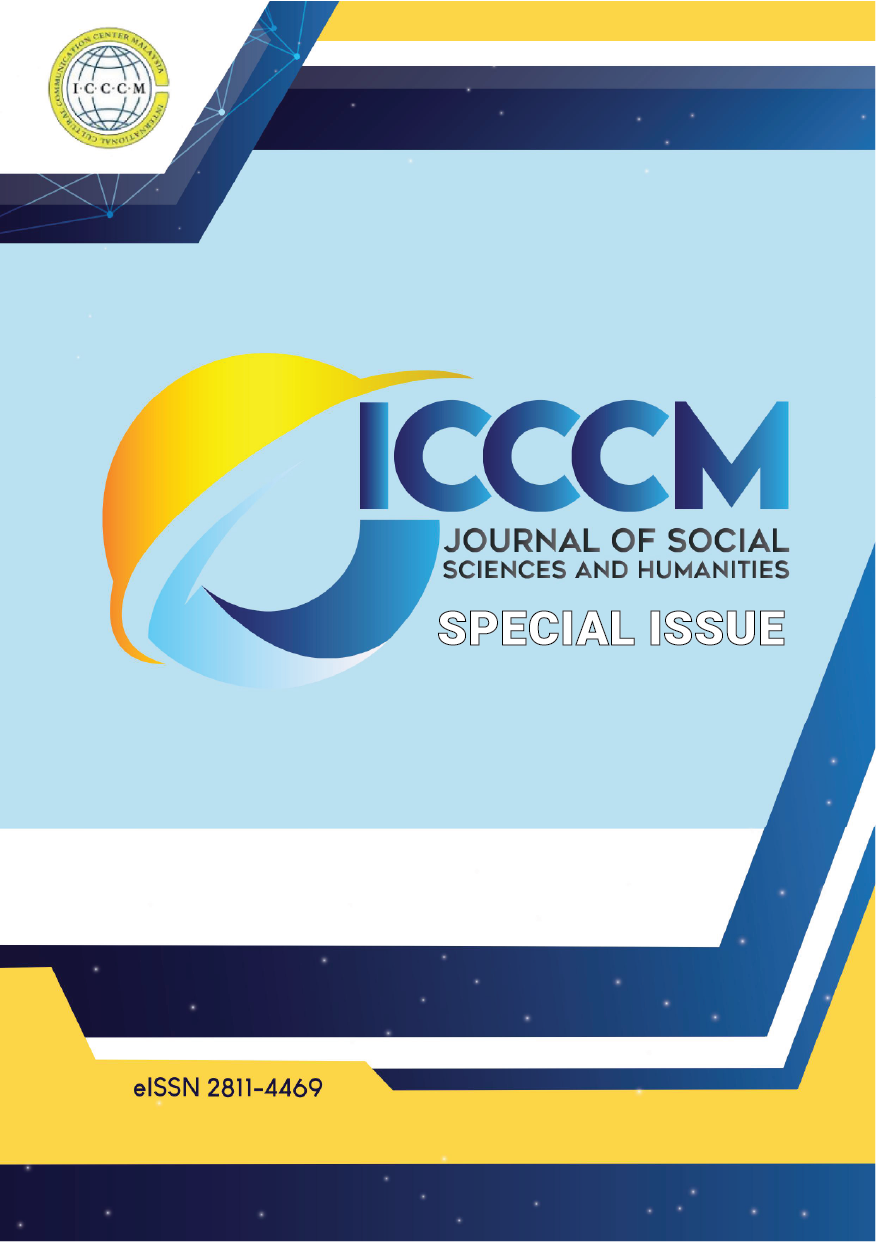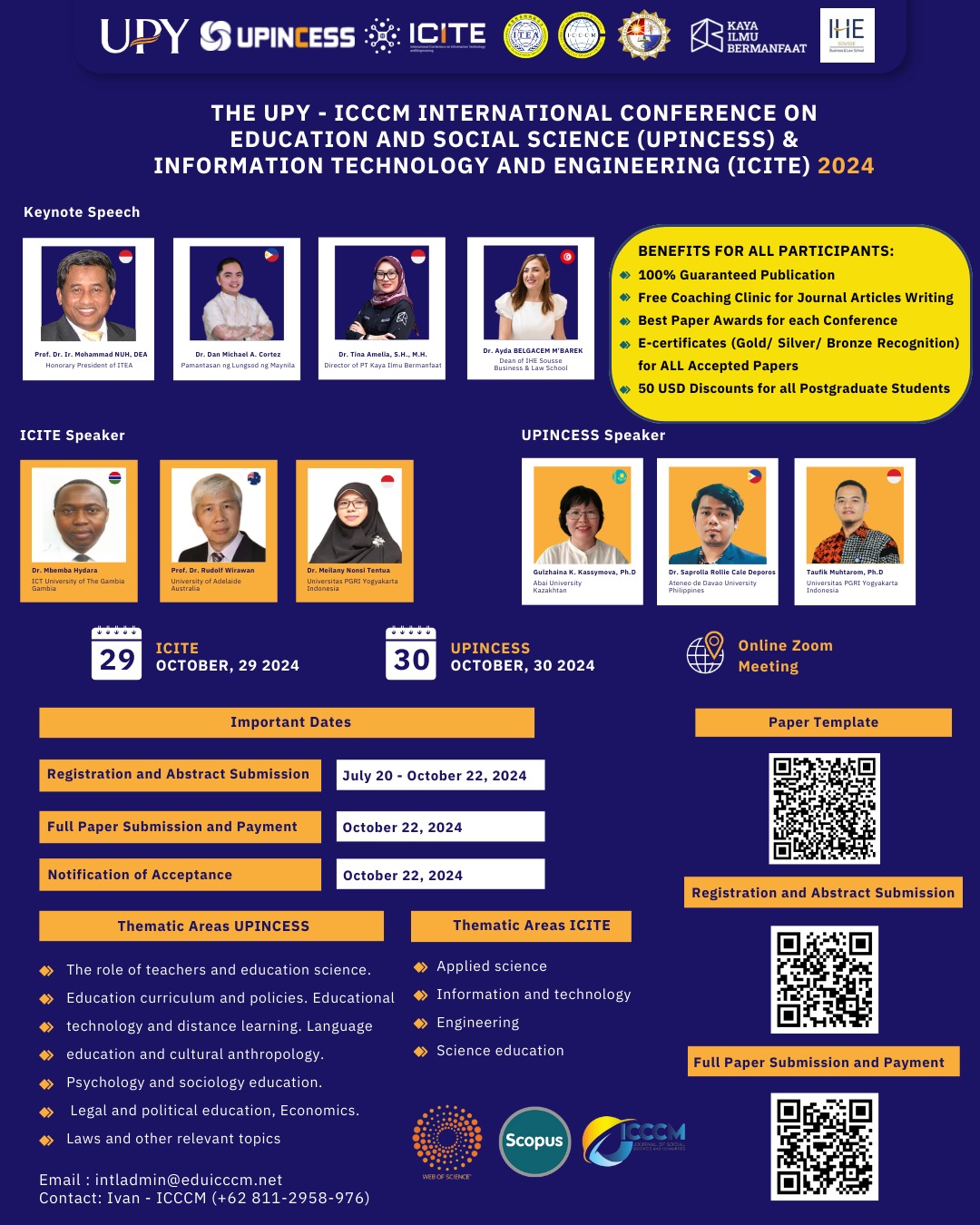Microsoft Teams as an Online Learning Media in Social Education Subjects at SMP Negeri 12 Yogyakarta
DOI:
https://doi.org/10.53797/icccmjssh.v4.sp.36.2025Keywords:
Microsoft teams, media, blended learningAbstract
This study aims to determine the implementation of Microsoft Teams as a blended learning media and the obstacles experienced by teachers and students in using Microsoft Teams in social studies subjects at SMP Negeri 12 Yogyakarta. This research was conducted at SMP Negeri 12 Yogyakarta from December 2024 to January 2025. This study uses a qualitative method. Data were collected through observation, interviews, and documentation with the aim of collecting data as deeply as possible. The subjects of this study were 9 people, including: (1) one Deputy Head of Student Affairs at SMP Negeri 12 Yogyakarta; (2) one Deputy Head of Curriculum at SMP Negeri 12 Yogyakarta; (3) two Civics teachers; (4) 5 students at SMP Negeri 12 Yogyakarta. The data analysis technique is by means of data reduction, data presentation, and drawing conclusions. Data validity is achieved by means of triangulation, namely by comparing the data obtained with other data. The results of this study indicate that the implementation of Microsoft Teams as a blended learning media for social studies subjects at SMP Negeri 12 Yogyakarta has gone well. The form of implementation of blended learning using Microsoft Teams at SMP Negeri 12 Yogyakarta is carried out through 3 stages, namely: (1) learning preparation; (2) implementation of learning; (3) evaluation of learning carried out in order to achieve learning objectives. There are 3 obstacles experienced by teachers and students in implementing online learning using Microsoft Teams, including: (1) storage memory constraints; (2) network constraints; (3) large internet quota constraints.
Downloads
References
Aduba, D. E., & Mayowa-Adebara, O. (2022). Online platforms used for teaching and learning during the COVID-19 era: The case of LIS students in Delta State University, Abraka. International Information & Library Review, 54(1), 17-31. https://doi.org/10.1080/10572317.2020.1869903
Aires, A. P., Escola, J., & Lopes, N. (2021). Microsoft 365: A teaching and learning resource during the pandemic. In INTED2021 Proceedings (pp. 3647-3652). IATED. https://doi.org/10.21125/inted.2021.0755
Arifiati, N., Nurkhayati, E., Nurdiawati, E., Pamungkas, G., Adha, S., Purwanto, A., ... & Azizi, E. (2020). University students online learning system during Covid-19 pandemic: Advantages, constraints and solutions. Systematic reviews in pharmacy, 11(7).
Arifin, M., & Muzid, S. (2018). Analisa Tracer Studi Pada Universitas XYZ. Jurnal Disprotek, 9(2), 69-73. https://doi.org/10.34001/jdpt.v9i2.799
Cuadra, L. J., Aure, M. R. K. L., & Gonzaga, G. L. (2019). The use of tracer study in improving undergraduate programs in the university. Asia Pacific Higher Education Research Journal (APHERJ), 6(1). https://doi.org/10.56278/apherj.v6i1.1315
Evans, N. (2022). Microsoft Teams Supports Authentic Assessment of Learning. Journal of Teaching and Learning with Technology, 11, 37-50.
Harasim, L. M. (1995). Learning networks: A field guide to teaching and learning online. MIT press.
Hasan, N., & Khan, N. H. (2020). Online teaching-learning during covid-19 pandemic: students’ perspective. The Online Journal of Distance Education and e-Learning, 8(4), 202-213.
Ilag, B. N. (2020). Understanding Microsoft Teams Administration. Apress.
Karis, D., Wildman, D., & Mané, A. (2016). Improving remote collaboration with video conferencing and video portals. Human–Computer Interaction, 31(1), 1-58. https://doi.org/10.1080/07370024.2014.921506
Lusiana, B., & Maryanti, R. (2020). The effectiveness of learning media used during online learning. Media Pendidikan, Gizi, dan Kuliner, 9(2). https://ejournal.upi.edu/index.php/Boga/index
Muzari, T., Shava, G. N., & Shonhiwa, S. (2022). Qualitative research paradigm, a key research design for educational researchers, processes and procedures: A theoretical overview. Indiana Journal of Humanities and Social Sciences, 3(1), 14-20. https://indianapublications.com/Journals/IJHSS
Nuryatin, A., Rokhmansyah, A., Hawa, A. M., Rahmayanti, I., & Nugroho, B. A. (2023). Google classroom as an online learning media for Indonesian language learning during covid-19 pandemic. Journal of Language Teaching and Research, 14(1), 255-262. https://doi.org/10.17507/jltr.1401.27
Ramadhani, A. R., Muhammada, M., & Ma’ruf, A. (2024). Inovasi Media Pembelajaran Pendidikan Agama Islam Berbasis Microsoft Teams Di Smkn 1 Purwosari. At-Ta'dib: Jurnal Ilmiah Prodi Pendidikan Agama Islam, 20-31.
Sawhney, M. (2024). Microsoft Teams versus Zoom: Challenging the Challenger. Kellogg School of Management Cases, 1-11. https://doi.org/10.1108/case.kellogg.2025.000022
Sobaih, A. E. E., Salem, A. E., Hasanein, A. M., & Elnasr, A. E. A. (2021). Responses to Covid-19 in higher education: Students’ learning experience using microsoft teams versus social network sites. Sustainability, 13(18), 10036. https://doi.org/10.3390/su131810036
Watson, J. (2008). Blended Learning: The Convergence of Online and Face-to-Face Education. Promising Practices in Online Learning. North American Council for Online Learning.
Downloads
Published
How to Cite
Issue
Section
License
Copyright (c) 2025 S. A. Permana, F. R. Maryasd, C. Putri, A. M. Hasyim

This work is licensed under a Creative Commons Attribution-NonCommercial-ShareAlike 4.0 International License.




